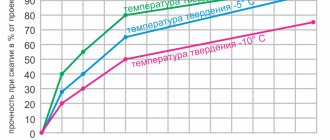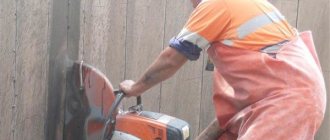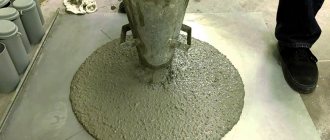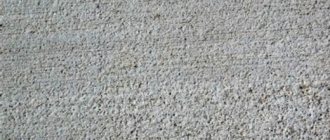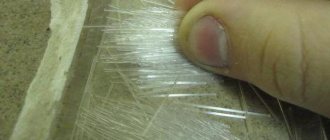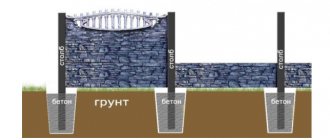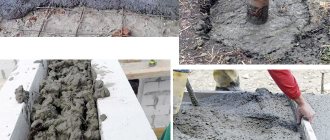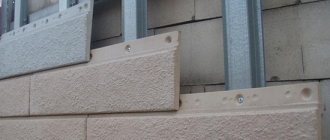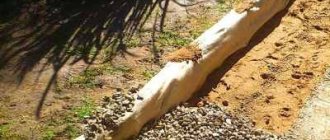Industrial construction does not stop during the cold season, but concrete hardening at subzero temperatures is problematic. Crystallization of water leads to a decrease in strength, which negatively affects the quality of structures. The use of antifreeze additives in concrete, a wide selection of which the industry offers today, will help solve the problem.
Operating principle
The use of antifreeze additives allows you to pour mortars at temperatures down to -50ºС. They are liquid or powdery formulations added to the mixture. It is important to know that concrete additives added during frost provide only 30% hardening. Final hardening occurs after the monolith is defrosted.
There are several types of antifreeze additives, differing in their principle of action:
- Compositions that lower the freezing point of the liquid, as a result, the process of cement hydration continues, setting proceeds according to the standard mechanism;
- Sulfate-based additives accelerate the compaction of concrete, which releases excess heat, increasing the rate of cement hydration;
- Complex additives increase the solubility and activity of cement laitance, while compounds resulting from the reaction with water reduce its crystallization temperature.
Application of antifreeze additives in summer
In hot weather, the temperature is sufficient for the concrete to set quickly. But, as a rule, this happens at low humidity.
Moisture from the concrete surface quickly evaporates, leaving the mixture dehydrated. The situation is similar to that in which water in the material freezes at negative temperatures.
Cement binder in conditions of lack of moisture does not fully undergo the hydration process. As a result, the concrete does not acquire the appropriate grade strength. Its structure remains heterogeneous. Cavities form in the depths, and cracks form on the surface. In winter, with repeated freeze-thaw cycles, such concrete quickly deteriorates.
The use of antifreeze additives allows for faster setting and improved hydration of cement with rapid evaporation of water. This has a positive effect on the properties and characteristics of concrete produced in hot, low-humidity weather.
Varieties
There are various antifreeze additives, each of which has its own mechanism of action. A popular additive is sodium carbonate, otherwise called potash. This is a powdery crystalline composition that accelerates the hardening of the concrete mixture. The use of an additive of this type reduces the technical characteristics of the material, including strength. To reduce this effect, sodium tetraborate is added to potash.
Attention! Potash is classified as a hazardous substance, therefore safety requirements are observed when working with it.
Sodium tetraborate is a complex substance consisting of sodium and calcium salts with the addition of ammonium. This is an additional antifreeze additive used with sodium carbonate. Without it, the structure can lose up to 30% of its strength after thawing and complete hardening.
Sodium nitrite is an effective antifreeze additive that reduces the crystallization temperature of water, accelerates the hardening of the composition, and has an anti-corrosion effect. Its use is dangerous, since sodium nitrite powder is a flammable, explosive, toxic substance. Used in frosts down to -25ºС. It cannot be mixed with lignosulfonic acids, since it releases toxic gas when interacting with them. Calcium nitrite has similar properties.
Sodium formate is an antifreeze additive for concrete, reducing the crystallization temperature of water and accelerating the hydration of cement. It is added in a proportion of no more than 6% of the total mass of concrete. To improve plasticization, naphthalene lignosulfonate is added to the additive.
Urea is a PMD, prolongs the liquid phase of water, and has virtually no effect on the setting speed.
Calcium and sodium chlorides, ammonia water reduce the freezing point, but have an increased corrosive effect. They have a strong effect on metal elements and are therefore not recommended for use in reinforced concrete products.
Properties of concrete additives
Hardening accelerators are produced by industry in a wide range and have different properties. Some of them have been known for a long time and various modifications of additives have been developed on their basis.
Potash (potassium carbonate) is a product of alumina processing. Widely used in Eastern Siberia due to its availability and low cost.
Potash (potassium carbonate)
Positive properties:
- incombustible,
- non-toxic,
- does not cause corrosion of embedded parts and fittings,
- does not cause fading or efflorescence.
Negative properties:
- cannot be used with alkali cements, sand-lime bricks, because strong alkalis are formed,
- the manufacture of bridges, overpasses and roads is not allowed due to deterioration in strength to withstand dynamic loads,
- increases electrical conductivity, so should not be used near a voltage source,
- requires the use of retarders, because at positive temperatures thickens quickly,
- highly hygroscopic, at high humidity it cakes and loses solubility,
- Due to the strong alkaline reaction, it is necessary to work while observing personal protective measures.
Sodium nitrite is produced by many chemical plants in the form of a crystalline powder or solution. The maximum concentration is 0.1-0.4 l/kg of cement.
Pros:
- dissolves well
- does not cause corrosion of metals,
- increases the hardening speed and strength by one and a half times.
Minuses:
- due to the alkaline reaction, corrosion of concrete and the appearance of salt stains on the surface are possible,
- poisonous, dangerous to human life,
- fire and explosion hazard.
Calcium nitrite-nitrate is produced by the chemical industry as an intermediate product for the production of calcium nitrate in the form of solutions or pastes.
Pros:
- accelerates concrete hardening,
- does not destroy metal
- affordable.
Minuses:
- poisonous,
- explosive and fire hazardous,
- causes cracking of concrete when reinforced with thermally strengthened metal.
Nitrite-nitrate-calcium chloride is a mixture of calcium salts 1:1:2. It is made from waste from the chemical industry, so it is very cheap. Available in the form of solutions. The characteristics are very similar to calcium nitrite-nitrate. Safety precautions are similar.
Sodium formate is produced from waste from the oil refining industry. Dissolves in water with heat absorption. Used in combination with plasticizers. The permissible concentration is 2-6% by weight of cement. An alcohol solution of sodium formate is a clear, brownish liquid. Added to water for mixing concrete.
Urea (carbamide) has good solubility in water and does not cause efflorescence or stains. The fittings do not corrode. Explosive, store only in fireproof areas. Lowers the freezing point of liquid and is also used as a plasticizer.
Urea (urea)
Ammonia water is a 10-12% solution of ammonia in water. Very cheap and effective supplement. Widely used in construction. There is no metal corrosion and does not form efflorescence. The downside is the unpleasant pungent smell.
Sodium chloride (table salt) is a well-known food additive. Harmless, easily soluble, affordable. Disadvantages - causes corrosion of reinforcement, wet spots on the surface of concrete. When combined with fatty acids, it works well as a hardening accelerator at low temperatures.
Calcium chloride is an inexpensive table salt for cheese production. Found application as an antifreeze additive back in 1888. Non-toxic, non-flammable, non-explosive. An effective hardening accelerator, can even be used in combination with aged cements. Gives increased abrasion to concrete and the ability to use it in the construction of floors, road surfaces, and sidewalks.
Disadvantages: hygroscopicity, can increase concrete shrinkage. Causes corrosion of metals when moisture enters through a layer of material. Therefore, additional protection of the reinforcement is required. It is prohibited to use such additives in prestressed structures.
Complex antifreeze additives additionally contain plasticizers, retarders or accelerators, and substances that reduce corrosion. This allows you to optimize the use of reagents in specific conditions.
How to use
The choice of additive and the method of its application depends on the condition and material where it will be introduced. Any additives to concrete used at sub-zero temperatures are added to the solution with water, according to the instructions from the manufacturer. After thorough mixing, it is recommended to wait a while for this component to diffuse through the composition.
According to SP 70.13330.2012, in order for the composition to achieve the required strength, it is important that before the temperature of the composition reaches the level for which the additive is designed, it gains no more than 20% of the planned strength.
The consumption of antifreeze additive per 1 cubic meter of material depends on the average daily ambient temperature. Up to -5 degrees it is recommended to add up to 2% of the additive by weight of the solution, up to -10 degrees this figure increases to 3%, up to -15 degrees no more than 4%. In severe frosts, calculations are made individually for each type. The rate of hardening of the solution decreases, and maximum strength is achieved after the end of frost.
When adding plasticizers and PMD, certain operating rules must be followed. The recommended range for the solution to be poured is from +15 to +25ºС. To dissolve additives, a certain amount of water is required, which must be heated, this ensures complete dissolution of the substances. Sand and crushed stone used in the solution are also heated immediately before adding. Cement cannot be heated, as it will lose its astringent properties. The poured solution must be covered, this is especially true during snowfall.
Advantages and disadvantages of additives
The main advantage of concrete with anti-frost additives is the ability to perform work all year round. Selected in the correct proportion, they improve the adhesion of the components, increasing the quality of the solution. They have other advantages:
- increasing service life due to concrete compaction;
- increase the plasticity of mixtures, making them easier to work with;
- the frost resistance of ready-made concrete increases, which is important for elements of load-bearing structures;
- the use of PMD is the cheapest method of filling at subzero temperatures;
- the use of additives reduces shrinkage during solidification, maintaining the integrity of the structure;
- anti-frost additives fill the pores of concrete, thereby significantly increasing its water resistance;
- some compositions significantly increase the corrosion resistance of the monolith, extending the service life of structures, buildings and structures significantly.
The use of antifreeze additives also has its disadvantages. If used incorrectly, the strength characteristics of concrete are reduced, so when working, you must strictly adhere to the instructions. Some additives are flammable and toxic, which must be taken into account when working with them. Even with additives, in frosty conditions the hardening rate will be relatively low. To achieve the required strength when laying in winter, a larger amount of cement is required, which increases the cost of construction.
Application of antifreeze additives in concrete
For the most effective action, hardening accelerators are recommended to be used in the form of solutions. The grade of cement used must be at least PC 400. Work should be carried out at temperatures down to -15°.
Some additives can be used at lower temperatures. Methods for preparing concrete in stationary conditions of concrete mixing units and on open-air construction sites differ.
The sequence of preparing concrete with antifreeze additives in the field :
- Heat the water or prepared concentrate for the solution to 40-80°.
- Prepare a solution of water and a dry chemical reagent of the required concentration (or liquid concentrate). Mix all components thoroughly in a concrete mixer until the sediment disappears.
- Pour in cement, sand and crushed stone in the required proportions.
- Stir for at least 2-3 minutes.
- Start concreting.
Application of antifreeze additives
Some additives are recommended to be mixed with dry cement. Before preparing the concrete mixture, you should carefully read the instructions.
Do-it-yourself anti-frost additives
In private construction, if it was not possible to carry out all the work in the warm season, it is necessary to continue in the winter. Therefore, it is allowed to prepare antifreeze additives for concrete with your own hands at home. To do this, you only need table salt or sodium chloride. This additive reduces the freezing point of water and reduces the critical hardening time of the mixture.
To make an anti-frost additive for concrete with your own hands, salt is dissolved in water and added to the solution. Concentration up to -5 degrees is 2% by weight of the solution, up to -15 degrees, the mass fraction of chloride reaches 4%.
The disadvantage of this additive is its corrosion activity towards metal, so it is not suitable for reinforced concrete structures. It must be taken into account that the rate of hardening of the solution at negative temperatures will be, on average, 3 times lower than under normal conditions.
Antifreeze additive to the solution: description and properties
Date: January 30, 2017
Comments: 0
Frost-resistant additives in cement mortar
When carrying out construction and repairing buildings in winter, builders are faced with serious problems associated with negative temperatures. It makes hardening of the concrete mass difficult. This is due to the increased concentration of water contained, which begins to freeze at -3 degrees Celsius. At the early stage of concrete hardening, frozen water expands, destroys the mass, violates the integrity, reduces strength, which affects durability.
If it is necessary to carry out concreting in winter, special antifreeze additives are introduced into the cement mortar to ensure the necessary hydration time. Their introduction increases the homogeneity of the mixture, strength characteristics, makes cracking more difficult, and reduces the duration of hardening.
Antifreeze additives in the solution contain hydrochloric acid, sodium and calcium chloride, and other components. They increase the plasticity of the composition, have a positive effect on frost resistance, accelerate the hardening process and the quality of the monolith. Let's consider the purpose of the additives used, the effect on the cement mixture, and the specifics of application.
As a rule, when the ambient temperature drops significantly, builders begin to experience additional difficulties when working with concrete and all kinds of solutions
Application area
Antifreeze additives in concrete mortar are used when performing work in the winter season. Naturally, winter complicates construction activities and introduces a number of serious restrictions on the performance of work related to concreting.
Professional builders have found a way out of this situation and are introducing frost-resistant additives into cement mixtures, allowing construction and repairs to be carried out when the temperature drops to minus 25 degrees Celsius. The scope of use is quite wide:
- construction of monolithic concrete structures;
- production of reinforced concrete products, prefabricated concrete products at reinforced concrete factories;
- construction of structures using steel reinforcement;
- formation of elements and individual parts of prefabricated building structures;
- sealing joints of monolithic-prefabricated objects;
- performing a screed;
- plastering the surface;
- preparation of mixtures for masonry with improved technological characteristics;
- preparation of dry building compositions for fixing facing elements;
- production of foam blocks, slag-based products with the required performance characteristics.
Plasticizers allow you to carry out a range of work in winter, starting with the traditional laying of brick or block walls, and ending with the construction of monolithic concrete structures using permanent formwork technology.
Using anti-frost additives in concrete, you will be able to carry out concrete work on a construction site even in winter.
Effect of additives
An anti-frost additive introduced into the concrete mixture, according to the manufacturer’s recommendations, has a positive effect on the performance characteristics:
- Increases the resistance of cement mortar to the influence of negative temperatures.
- Maintains the integrity of the concrete monolith during numerous cycles of deep freezing followed by thawing.
- Increases the resistance of concrete to permeability of the mass by water.
- Significantly increases strength characteristics after hardening.
- Significantly reduces setting and hardening time at subzero temperatures.
- Slows down corrosion processes associated with increased concentrations of chlorides.
Antifreeze additives for the solution are prepared independently, using plasticizers offered on the construction market, or you can order compositions specially prepared for working at subzero temperatures.
Providing increased performance properties of the cement composition is associated with the following features of the introduced components, which are:
- reduce the temperature threshold for freezing water;
- increase the plasticity of the solution, reducing the volume of water required for mixing;
- increase the density of concrete, which after laying retains its physical properties and has time to harden;
- ensure homogeneity of the cement mixture;
- improve the adhesion coefficient of concrete to steel reinforcement.
The additive to the solution can be combined with special plasticizers, which increase the individual characteristics of the mixture. The possibility of joint use is regulated by manufacturers of antifreeze ingredients. The use of special solutions makes it possible to reduce the freezing point of water in concrete mortar from 0 °C to -25 °C.
Specifics of use
Additives to the solution provide the required effect, subject to the percentage concentration. If the recipe is not followed or additives are introduced that deviate from the manufacturers' recommendations, the hydration process will stop and the cement will freeze.
When the temperature increases by 4-5 degrees Celsius, the hydration process will resume, but the structure of the concrete mass will change, which will affect the strength characteristics.
Due to the high strength of products made using anti-frost additives in concrete, they can be used for industrial purposes
Antifreeze additives introduced in the required quantities improve water resistance, increase density, slow down corrosion processes, and also increase the strength of the massif.
An important feature of the use of antifreeze ingredients is compliance with safety requirements. Sodium nitrate and potash used at subzero temperatures are poisonous and dangerous to human health components. It is unacceptable to get them on the skin, as well as on the mucous membrane.
When using frost-resistant additives in a concrete mixture, use special overalls, gloves to protect your hands, and goggles. Ensure that substances are stored indoors.
Economic feasibility of application
The introduction of frost-resistant ingredients into cement mortar is economically beneficial and quite simple from a technological point of view.
You can prevent the mixture from freezing to form a strong structure in the following ways:
- Heating the concrete mass using air guns until operational strength is achieved, which is a fairly energy-intensive procedure and technologically problematic.
- Heat using construction hair dryers, forcing a stream of hot air under the preheated surface of the concrete mass.
- Use welding machines that heat the steel wire in the solution. The process requires compliance with special safety requirements and is not economical.
- Use frost-resistant components of complex action, which make it possible to ensure the technological regime of concrete hardening and achieve operational strength with minimal financial costs.
The antifreeze additive provides twice the cost savings compared to steam heating and one and a half times more economical than electric heating. The introduction of special additives into the cement mortar ensures a reduction in the commissioning time of concrete structures.
Types of Ingredients Injected
Special frost-resistant components introduced into the concrete solution reduce the freezing threshold of water and do not allow it to freeze.
Using antifreeze additives, you will significantly reduce the risk of shrinkage deformations of a concrete monolithic structure
The following are used as antifreeze additives:
- sodium nitrite, which is also called sodium nitrite. It is used when carrying out construction activities when the temperature decreases to -15 degrees Celsius;
- potassium carbonate, which is known as potash, used during concreting at temperatures up to - 30°C. The introduction of components does not cause corrosion processes on the reinforcement and the appearance of salts on the surface of hardened concrete;
- chlorine-containing sodium and calcium compounds, which provide the possibility of winter concreting, but accelerate the corrosion destruction of steel reinforcement elements.
When preparing a frost-resistant composition, take into account the manufacturer’s recommendations, ambient temperature, and the concentration of additives corresponding to the proportion of cement.
For example, when the air temperature changes from -5°C to -15°C, the consumption of potash introduced into the cement composition increases from 5% to 10%, and sodium nitrate - from 4% to 8%. According to the type of antifreeze additives, their concentration in the cement mixture varies from 2% to 10%.
Along with special additives, plasticizers are introduced to ensure antifreeze characteristics. Their introduction helps to increase the plasticity of the solution, characterized by a reduced water concentration. The concentration of plasticizing substances varies depending on the type of work performed:
- When doing brick or block masonry, the concentration is 5-10% by weight of cement.
- For concreting, the concentration of plasticizers increases to 10-15%, which allows the concrete to turn into a monolith before the contained moisture freezes.
Plasticizers significantly increase fluidity and are not used for plastering work, during which they can drain from the surface of the walls before they have time to set. The integrated use of various hardening accelerators significantly improves the quality of concrete and performance characteristics.
Use of ready-made formulations
The use of ready-made dry mixtures with antifreeze ingredients is widely used when performing construction work in winter. Ready-made compounds produced using industrial technology are used for the following work:
- performing masonry using heavy mixtures, as well as cement compositions (with the addition of lime) with a volumetric weight of more than 1.5 t/m3;
- production of finishing activities using cement-lime mixtures with a density of less than 1.5 t/m3.
Using industrially pre-prepared anti-freeze compounds is much more convenient than mixing it yourself for special purposes. In this case, there is no need to take into account the compatibility of ingredients and select a recipe. However, ready-made compositions are characterized by a high price, which increases the estimated cost of construction in winter.
Preparation for using a ready-made antifreeze composition at home requires diluting the mixture with warm water and thoroughly mixing using a special attachment for the drill.
Conclusion
Understanding the relevance of carrying out construction activities in winter, it is advisable to use frost-resistant additives in concrete solutions, which ensure the ability to carry out work at a significant decrease in temperature. A qualified approach to the selection of antifreeze components and adherence to the recipe will not only significantly speed up construction work, but also ensure a reduction in the duration of activities and improve the quality of concrete structures.
pobetony.ru
